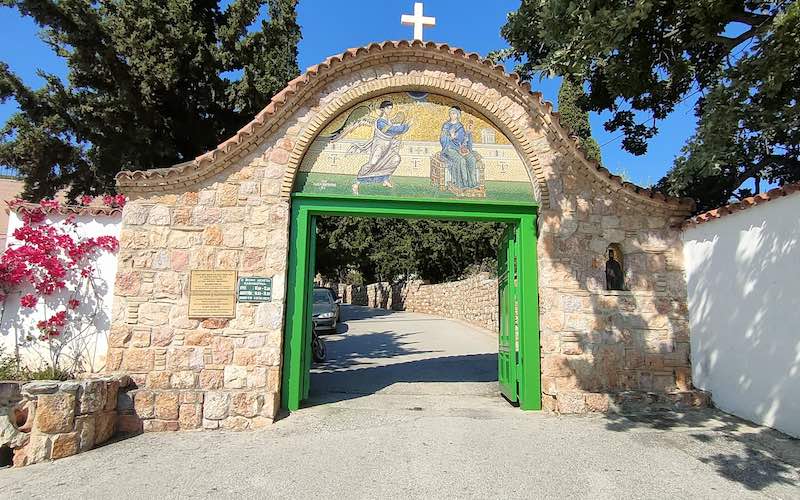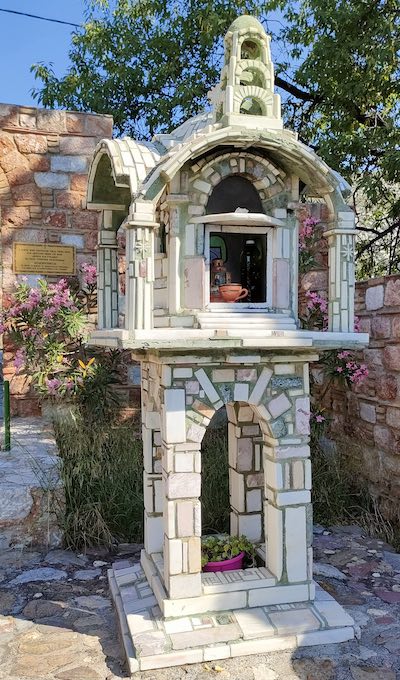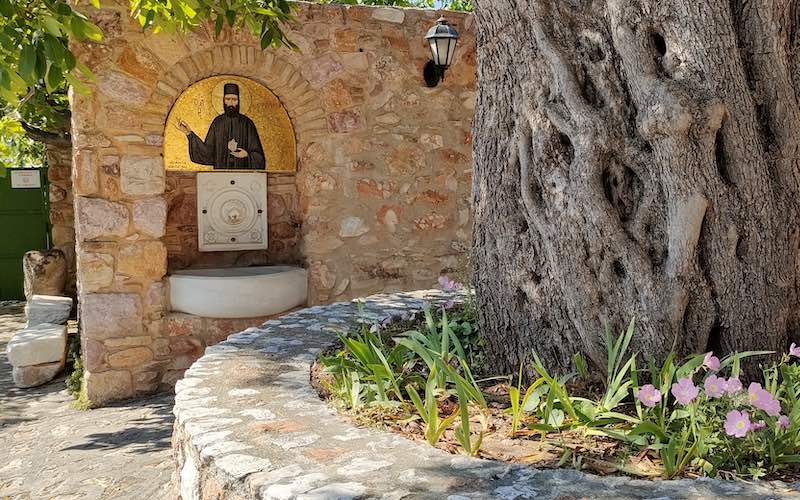This week, I’m here in Nea Makri, Greece, finding out about St. Ephraim (St. Ephrem) at the nearby monastery. St Ephraim, also known as St. Ephraim the New Martyr, was a Christian saint and martyr who lived in the late 18th century and early 19th century. He is venerated as a saint in the Eastern Orthodox Church and the St Ephraim monastery in Nea Makri was named after him. Visiting the St Ephraim monastery is one of the best things to do in Nea Makri. It’s nestled peacefully up the hill around 10 minutes drive from Nea Makri town centre.

All photography on this blog is my own – there are no photos of inside the monastery buildings or main Church as it is an active place of worship and internal photography is not allowed.
Who was St Ephraim?
Ephraim was born in the village of Nea Makri, near Athens, Greece, in 1384. He became a monk at a young age and lived a life of asceticism and devotion to God. He was known for his humility, prayerfulness, and compassion towards others.
During the period of Ottoman rule in Greece, Ephraim openly professed his Christian faith and refused to convert to Islam. As a result, he faced persecution and was imprisoned multiple times. Despite the hardships he endured, Ephraim remained steadfast in his faith and continued to inspire others through his piety.
In 1426, Ephraim was arrested again, this time for his refusal to obey the Ottoman authorities and for his evangelistic activities. He was brought before the Ottoman governor and given the opportunity to renounce his Christian faith, but he refused. As a result, he was subjected to severe torture and eventually martyred on June 5, 1426. He was beheaded, and his body was thrown into the sea.
St. Ephraim of Nea Makri is considered a martyr for his unwavering commitment to Christ and his refusal to compromise his beliefs. He is revered as a source of spiritual inspiration and a model of faithfulness in the face of persecution.

Introduction to the St Ephraim Monastery
In Nea Makri, the place of his martyrdom, a church dedicated to St. Ephraim was built, and it became a significant pilgrimage site for Orthodox Christians. Many miracles and healings have been attributed to his intercession, and he is particularly venerated for his ability to heal mental and emotional illnesses. It is very easy to visit the Monastery from Nea Makri, and I would definitely recommend it. It’s one of the oldest monasteries in Attica.
How to get to St Ephraim Monastery
From Nea Makri centre, you can visit St Ephraim very easily. It’s just a 45 minute walk inland from the coast, or you can jump in an Uber or Free Now (it shouldn’t cost you more than €7). There is a car park there where you can get dropped off.

Visiting Saint Ephraim Monastery
There are a few things that you need to bear in mind when visiting the monastery. It is an active place of worship and pilgrimage for Orthodox Christians and so you will need to dress conservatively and show respect at all times.

It is not allowed to talk or make noise inside the monastery and you will need to dress conservatively (no shorts, skirts, low tops or arms showing). Photography is allowed of the outside buildings but will be not allowed inside monastery buildings and the main Church.
Entering the Monastery – Shrine and Graves
Go through the main gate with an Orthodox Mosaic above it. Then walk in and to the right to enter the monastery. On the right, you will see a small shrine. There are also some beautifully decorated graves as you would round to the main Church. The monastery itself is free to enter, but you are encouraged to make a small donation to the upkeep of the monastery.

Main Courtyard
You will enter into the main courtyard which is peaceful and relaxing with beautiful trees and flowers. There is somewhere that worshippers can purchase candles and borrow head scarves.

Main Church and Tower
St Ephraim Monastery itself is a medieval Orthodox monastery with vividly painted interiors, gilded orthodox icons and a stone bell tower. Inside the main Church you will see a beautifully painted dome with Orthodox iconography (relating to the life of Saint Ephraim) and a beautiful hanging chandelier. There are smaller side chapels where people will be actively worshipping. You are likely to see a chanting Orthodox priest inside and people praying and crossing themselves. Remember not to take photographs inside the Church and do not photograph people praying.
Within the main Church building is preserved the sacred mulberry tree where Saint Ephraim was Martyred. He was tortured to death on 5 May 1426, when he was said to be hung from the tree by Arab invaders.

St. Ephraim Saint Day – 5th June
St. Ephraim of Nea Makri is celebrated as a saint on June 5th in the Eastern Orthodox Church calendar. His life and martyrdom continue to be an example of faith and devotion for believers to this day. This may not be the best day to visit the monastery as it is a pilgrimage day and gets extremely busy.
Tips for Visiting St Ephraim Monastery in Nea Makri
- Uber will work from Nea Makri or you can walk there in about 45 minutes (but it’s all uphill!)
- Dress conservatively – full trousers and long sleeves (no skirts or shorts)
- Take coins for a donation.
- Avoid photography inside the Monastery buildings.
- Remain silent inside the monastery courtyard and buildings.
- Avoid Holy days particularly St Ephraim Saint Day (5th June) as it will be too busy.
- Opening times 7am-12noon and afternoon from 4pm-6pm.

Further Reading and more places to visit in Nea Makri
If you are interested in archaeological sites you might be interested in visiting the Sanctuary of the Egyptian Gods just 10 minutes drive away further up the coast. Nea Makri has some beautiful beaches and relaxing beach bars – check out this article on things to do in Nea Makri. You should also consider spending at least one day in Athens.

